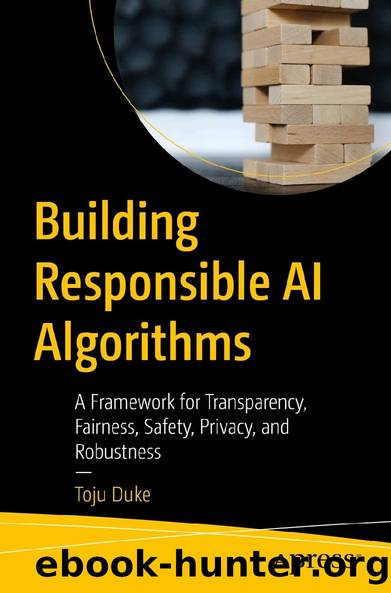Building Responsible AI Algorithms by 2023

Author:2023
Language: eng
Format: epub, mobi
Chapter 4 Fairness
Another mitigation strategy is to conduct adversarial sampling, where
samples are measured in the model for discrimination and bias and later
used to retrain the model, ensuring the discriminatory/unfair outputs are
excluded from the model.
Fairness Tools
There are several tools that you can use to measure fairness. Some of these
are described here:
⢠IBMâs AI Fairness 360 tool,109 a Python toolkit.
⢠Googleâs Learning Interpretability Tool,110 which
provides interpretability on natural language
processing mode behavior and helps identify
unintended biases.
⢠Microsoftâs Fairlearn,111 an open source toolkit
designed to assess and improve the fairness of AI
systems.
⢠PwCâs Responsible AI Toolkit,112 which covers the
various parts of responsible AI, ranging from AI
governance to policy and risk management, including
fairness.
⢠Pymetricsâ audit-AI tool,113 which is used to measure
and mitigate the effects of potential biases in
training data.
⢠Synthesizedâs Fairlens,114 an open source library
designed to tackle fairness and bias issues in ML.
⢠Fairgen,115 a toolbox that provides data solutions with
respect to fairness.
73
Chapter 4 Fairness
Letâs take a sneak peek at one of these toolsâFairlearn by Microsoft.
Fairlearn is an open-source toolkit suitable for analyzing fairness issues
in ML systems. It looks at the negative impact and harms of models on
different groups of people, giving clear focus to attributes such as race,
sex, age, and disability status. Its metrics and dashboard provide insights
into the specific groups of people who could be negatively impacted by a
model. Fairlearn also has âunfairnessâ mitigation algorithms that can help
mitigate unfairness in classification and regression models. Fairlearnâs
two components, an interactive dashboard and mitigation algorithms,
are aimed at helping to navigate tradeoffs between fairness and model
performance, where fairness metrics appropriate to a developerâs setting
are selected and choices are made toward the most suitable unfairness
algorithm to suit the developerâs needs. Here are more details about its two
components:
⢠The interactive dashboard: This has two general uses,
(a) to help users assess groups that might be negatively
impacted by a model and (b) to provide model
comparison between multiple models in relation to
fairness and performance. As an example, Fairlearnâs
classification metrics include âdemographic parity,
equalized odds, and worst-case accuracy rate.â
⢠The unfairness mitigation algorithms: The unfairness
mitigation algorithms are composed of two different
algorithmsâpostprocessing and reduction algorithms.
The postprocessing algorithm evaluates trained models
and adjusts the predictions to satisfy the constraints
specified by the selected fairness metric while working
toward maximizing the modelâs performance, for
example, ensuring a good accuracy rate. The reduction
algorithms âtreat any standard classification or
regression algorithm as a black box and iteratively
74
Download
This site does not store any files on its server. We only index and link to content provided by other sites. Please contact the content providers to delete copyright contents if any and email us, we'll remove relevant links or contents immediately.
The Mikado Method by Ola Ellnestam Daniel Brolund(20724)
Hello! Python by Anthony Briggs(20010)
Secrets of the JavaScript Ninja by John Resig Bear Bibeault(18332)
Dependency Injection in .NET by Mark Seemann(18209)
The Well-Grounded Java Developer by Benjamin J. Evans Martijn Verburg(17687)
OCA Java SE 8 Programmer I Certification Guide by Mala Gupta(17496)
Kotlin in Action by Dmitry Jemerov(17308)
Adobe Camera Raw For Digital Photographers Only by Rob Sheppard(16937)
Algorithms of the Intelligent Web by Haralambos Marmanis;Dmitry Babenko(16319)
Grails in Action by Glen Smith Peter Ledbrook(15467)
Test-Driven iOS Development with Swift 4 by Dominik Hauser(10417)
Becoming a Dynamics 365 Finance and Supply Chain Solution Architect by Brent Dawson(8056)
Microservices with Go by Alexander Shuiskov(7820)
Practical Design Patterns for Java Developers by Miroslav Wengner(7722)
Test Automation Engineering Handbook by Manikandan Sambamurthy(7672)
Angular Projects - Third Edition by Aristeidis Bampakos(7160)
The Art of Crafting User Stories by The Art of Crafting User Stories(6611)
NetSuite for Consultants - Second Edition by Peter Ries(6534)
Demystifying Cryptography with OpenSSL 3.0 by Alexei Khlebnikov(6305)
